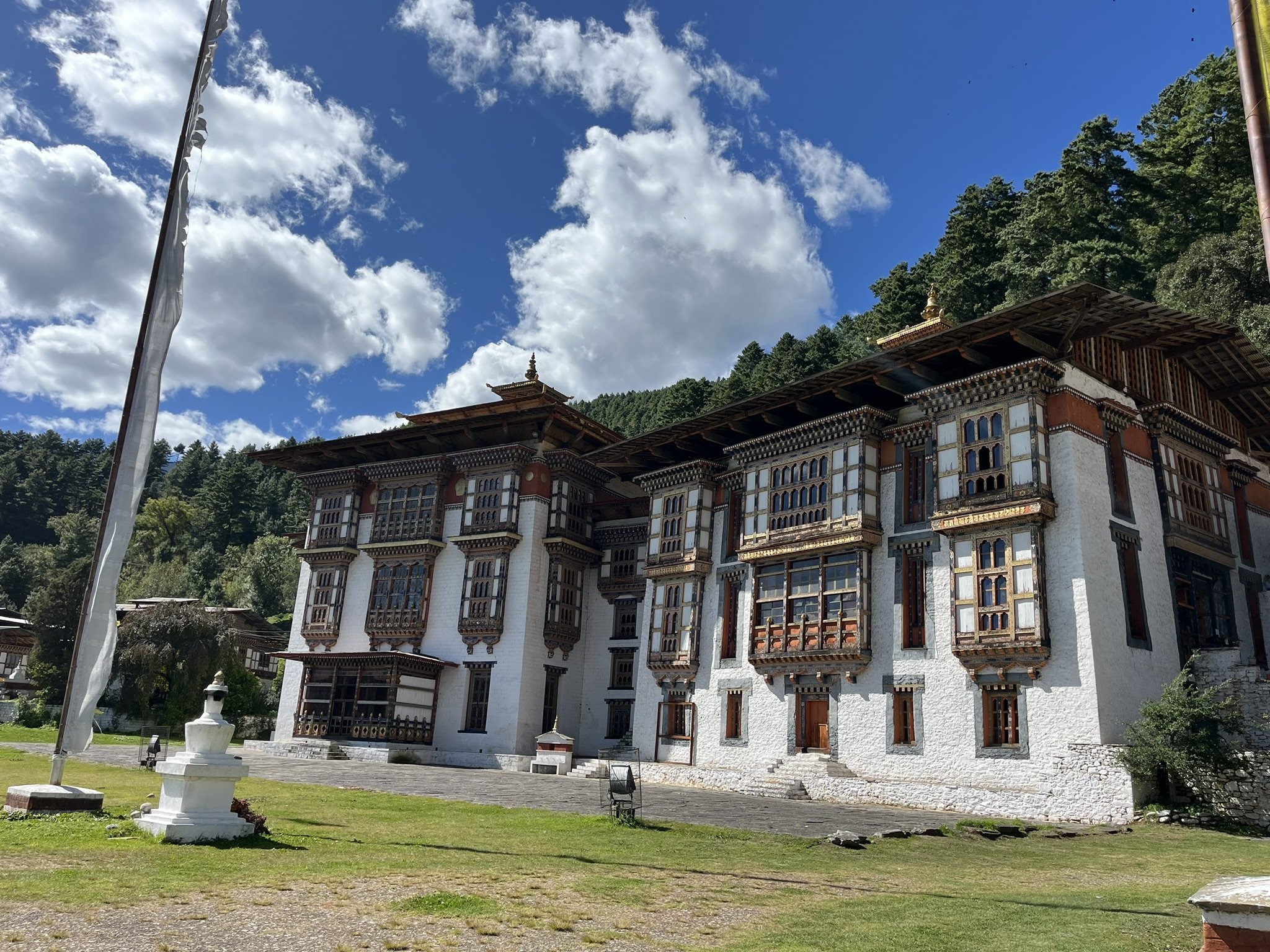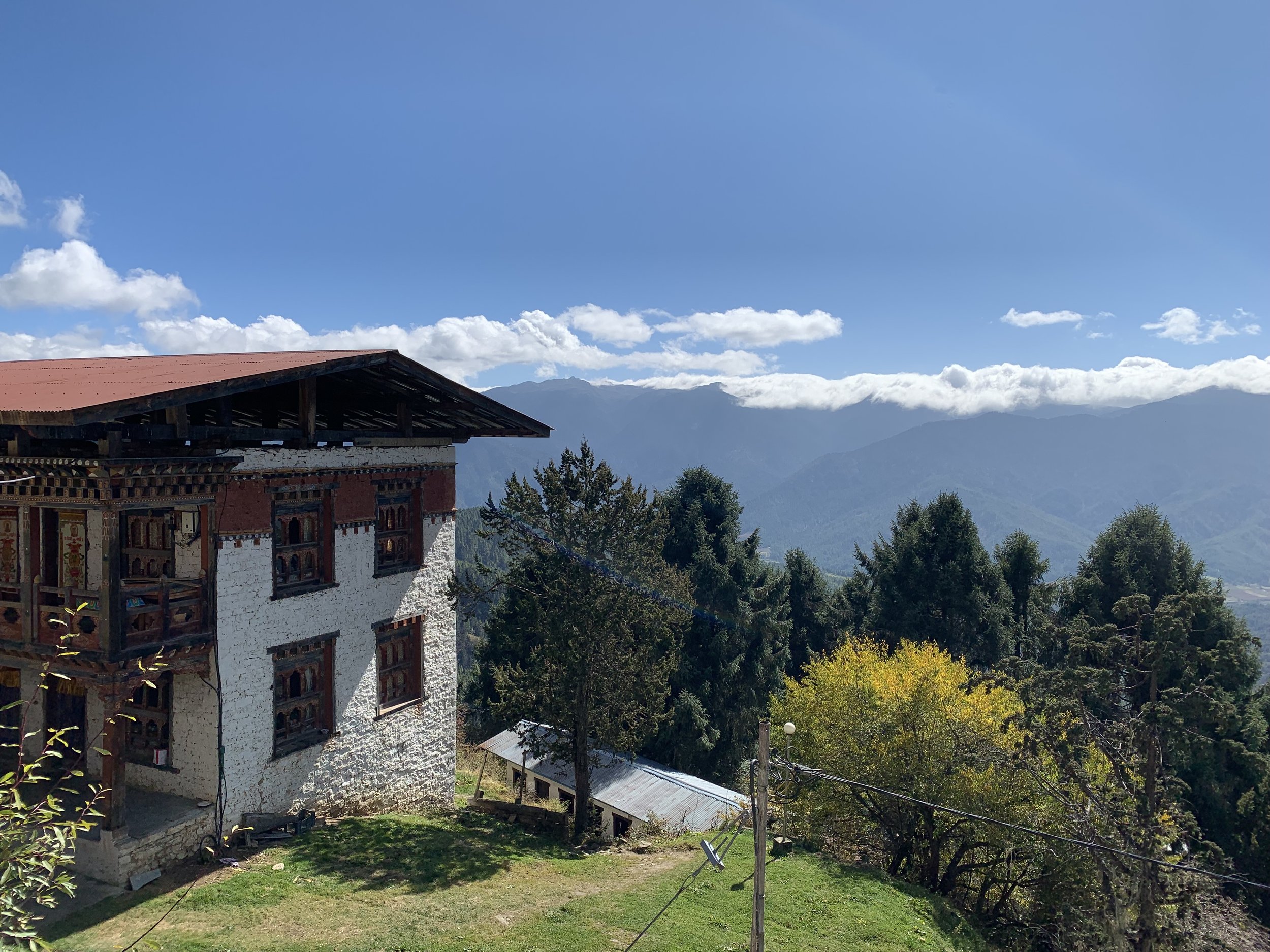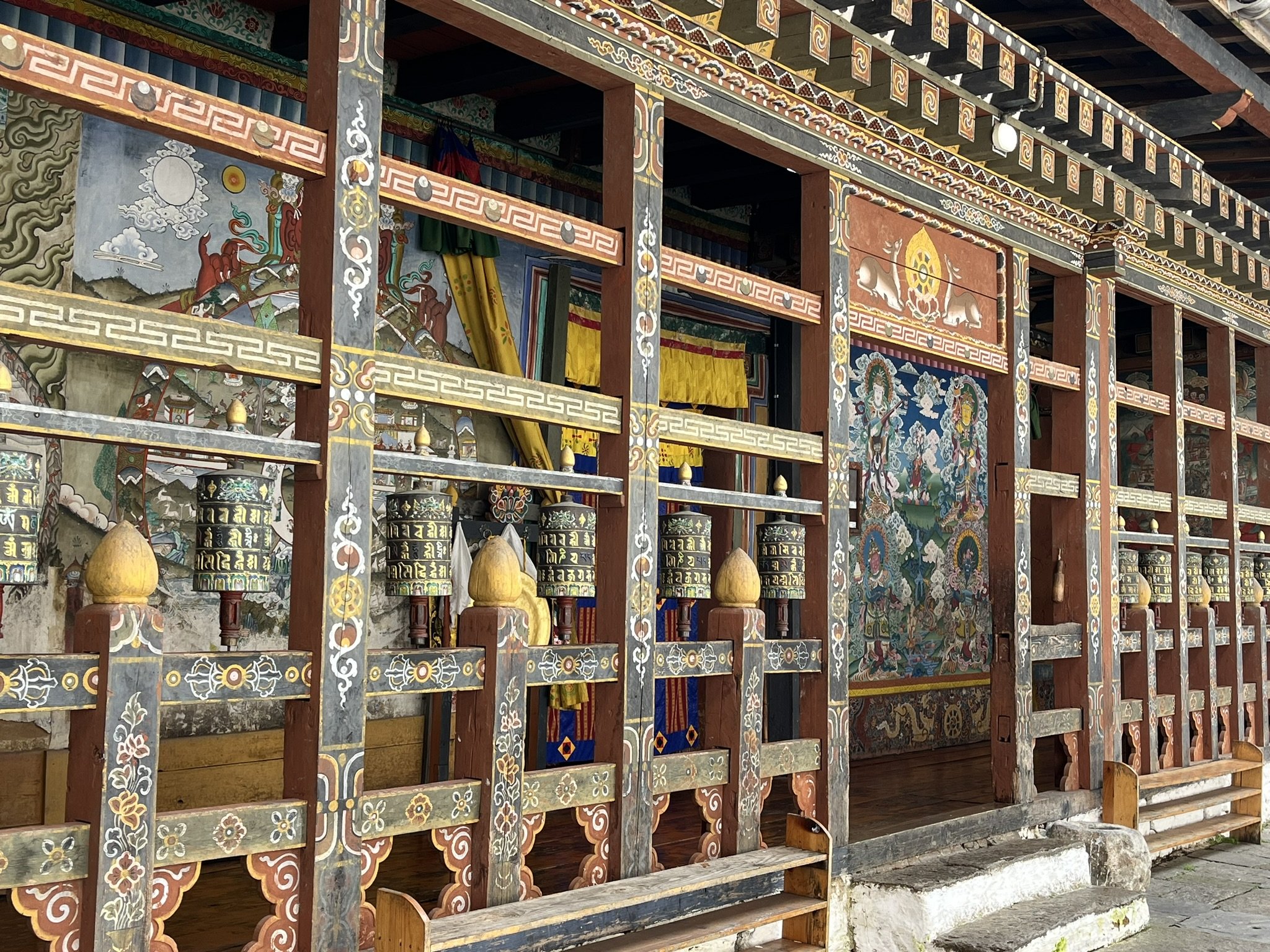Bhutan Pilgrimage: Reflections by Lama Palden
It was glorious to be back in Bhutan again! The rice fields were full of grain, just waiting to be harvested. Everything, including the deep blue sky, was washed clean after the monsoons of summer. Upon arrival a day early, Lama Döndrup and I had dinner with our hosts, Benchen Khenpo Rinpoche and his wife Rigdzin. They arranged an amazing pilgrimage for us. The next day our guides and helpers welcomed the whole group warmly, with true pleasure. Some of the pilgrims commented that they felt like they were home, just upon stepping out of the plane!
After staying the first night in Paro, we flew to Bumthang, former home to Guru Rinpoche (Padmasambhava), Yeshe Tsogyal, and Longchenpa, among many other great yogis and yoginis. We visited the cave, now with a temple (lhakhang) built out from it, where Guru Rinpoche had meditated. This lhakhang is called Kurjey. We meditated there and in many other wondrous lhakhangs in the area. One of the other most famous is called Jambay Lhakhang that the Tibetan King Songtsen Gampo built in 659 CE. In this complex is also a beautiful stupa holding relics from Benchen Khenpo Rinpoche’s last life.
Leaving Bumthang we drove way up a mountain to a monastery complex called Tharpaling that the Dzogchen master Longchenpa had revitalized in the 14 th century. It has again been undergoing renovation. Feeling like we are in the clouds, there is a gorgeous view of the mountains across the valley. We meditated in a beautiful new lhakhang here.
About an hour outside of Trongsa Dzong we had a delightful day at Karma Drubdey Nunnery. This was founded by Khenpo Tsultrim Gyamtso Rinpoche, one of my beloved teachers, and he visited us at Sukhasiddhi many times. Khenpo Rinpoche visited the nuns there for decades, teaching and also doing retreat. Since the three-year retreat center was in between sessions, we had the great good fortune to be allowed into it. A cave where Khenpo Rinpoche had practiced inspired us. There is also a huge rock there that he used to sky gaze from.
Trongsa Dzong is huge and magnificent. The dzongs have all the government offices for their district as well as a monastery and many lhakhangs. Trongsa Dzong also holds an incredible collection of relics that they show to the public once a year. They very kindly showed them to us. We were also allowed to meditate in the Tara Lhakhang. This was the first of several Tara temples that we were able to meditate in. The energy of Green Tara, White Tara, and Green Tara’s 21 forms is very alive is these places.
There were so many highlights to our pilgrimage, so many lhakhangs from the 7 th - 8 th century, so many powerful sacred places, that I can’t begin to tell you them all here, but I will mention a few other highlights. We went to previous (and current) Dilgo Khyentse Rinpoche’s private residence in the Paro Valley in order to pay homage to Rinpoche, and do kora around his stupa. We knew that the current Dilgo Khyentse was not in Bhutan at the moment, but we were able to do kora, and also read aloud a Dzogchen teaching from previous Rinpoche. Then, very delightfully we were invited into the private home and were able to have a long visit with the lama in charge.
In Thimphu Benchen Khenpo Rinpoche and Rigzin hosted us for an evening of food, music, and dance at the Cultural center. We even all got up and danced together eventually. It was a relaxing and fun evening.
Finally, most of our group made it up, and meditated in Taksang (Tiger’s Nest), and some of them went all the way up above to Machig’s cave, and to the lhakhang at the very top of the mountain. This was a powerful, luminous conclusion to an extraordinary pilgrimage. Those of us who weren’t able to go up had a glorious day as well, continuing to visit ancient temples and meditate in the morning. In the afternoon we visited the National Museum, which is housed in a 17 th century circular tower. Inside one winds around and around to see exhibits spanning Bhutan’s long history.
All in all, this was a most wondrous pilgrimage. The group really moved as one, in great harmony, with the uniqueness of each person shining forth. This was another huge blessing.
In all my years of living and visiting Bhutan, (I first moved there in 1979,) I had never seen and been in many special places. And returning again to places I had visited many times never grows old, but is fulfilling, nourishing, and a great blessing that I will always cherish.
We hope to go to Bhutan again in 2026 or 2027.
Blessings, and with great gratitude,
Lama Palden
Bhutan Pilgrimage Reflections
By Lama Döndrup
Pilgrimage in Bhutan was an extraordinary blessing. Though this was my first visit, I felt a deep sense of coming home as the plane descended into Paro. Having spent time on pilgrimage in India and Tibet, I was struck by how the dharma manifests uniquely in each of these lands, where spirituality is inextricably woven into every aspect of life.
What stood out to me in Bhutan was the ease and gentleness with which the dharma flowed, like a continuously bubbling stream—much like the sacred springs cascading down the mountains that we encountered along the way, freely offering their pure waters.
Our journey affirmed how pilgrimage unfolds on many levels, the most profound being the inner journey to our true nature—the secret pilgrimage at the heart of all spiritual practice. Visiting holy places infused with awakened energy inspired and propelled us forward on this inner path. The power of this transmission was palpable throughout the journey. We felt it through circumambulations, meditation, and resting in open, receptive presence, taking in the exquisite beauty of sacred art and deeply meaningful shrines. The land itself seemed imbued with timeless presence and wisdom, reflected in the reverence the Bhutanese people offer to it.
While every sacred site we visited was profound, the pinnacle of the journey for me was the pilgrimage to Taktsang, where we spent time practicing in caves in which both Guru Rinpoche and Yeshe Tsogyal meditated. We then climbed further up the mountain to meditate in Machig Labdrön’s cave and beyond that to a lhakhang at the mountain’s peak. The journey to these sacred caves felt like a pilgrimage in itself—a vivid reminder that pilgrimage is far more than simply traveling to a sacred place. It is embracing the challenges, obstacles, and joys of the journey while holding them in the context of practice, bodhicitta, and devotion to the lineage, awakened mind, and our true nature. Many of us inwardly chanted mantras with each step, cultivating a heartfelt connection with Guru Rinpoche, Yeshe Tsogyal, and Machig Labdrön. By the time we reached the caves, we were ripe to receive their blessings, and the experience was exquisite and deeply meaningful.
It was both moving and exhilarating to sing dedication prayers from the lhakhang at the mountain’s peak, overlooking Machig’s cave, Taktsang, and the vast valley below. As our voices rose into the open sky, it felt as though the prayers were carried on the wind, offering the blessings, merit, and benefit of our entire pilgrimage freely to all beings, seen and unseen, near and far, before we began our descent. Though we have returned, the blessings of the pilgrimage continue to unfold within us, deepening our practice and guiding us toward greater compassion, wisdom, and devotion.
With aspirations for future pilgrimages,
Lama Döndrup
From the Pilgrims:
“More than ever I believe in the power of pilgrimage. Not only did I have an incredible healing experience of my own, but I watched so many pilgrims have their hearts and minds open. The combination of Lama Palden’s leadership and presence, and Benchen Rinpoche’s (our Bhutanese travel agent) support in Bhutan, opens many, many doors to experiences that would not be possible otherwise. It was a profound pleasure to organize this trip from start to finish.”
“For someone wanting to touch the heart of Buddhism in a place that is such a pure expression, I think this pilgrimage is a perfect opportunity. I loved being in Bhutan, experiencing the culture, deepening my own practice, and being around like-minded people who are also committed to their spiritual practice. The time with the lamas was precious and I feel like I made some friends for life.”
“I think experiencing Bhutan in this way was unique and I was grateful to have Lama Palden as our leader - I felt many doors opened because of her relationships and that we experienced Bhutan in a way that was very heart opening.”
“It was a great experience from beginning to the end. For me it was a deep dive into the Vajrayana tradition. Our lamas were both amazing!”
“The Pilgrimage was one of those life changing events that come around every so often in one’s life. I’m deeply grateful for the opportunity to travel under the guidance of Lama Palden and for the community of fellow pilgrims on the journey - every day was a unique and deep experience.”
“My tapestry experience of Bhutan was woven with awe and gratitude: for stunning mountains and rivers; for deep camaraderie with other pilgrims; for mysterious spiritual energies in sacred spaces; for inspiration about how to live a better life; for the graciousness and good humor of our Bhutanese guides; for unforgettably beautiful murals and statues; for deepening my spiritual practice. And one particular mysterious healing: my fear of driving on roads alongside steep cliffs: suddenly and completely evaporated: no more fear!”














